The architect Kazuo Shinohara once observed that some of the most advanced machines in the world—fighter jets and spacecraft—do not conform to refined modern aesthetics. Their parts appear “clumsily joined together,” he wrote in a 1981 essay, lacking in “elegance from an architectural standpoint.” But in these machines’ refusal to cover up messiness with a veneer of beauty, Shinohara found the promise of a revelatory architecture: building as ungainly machine.
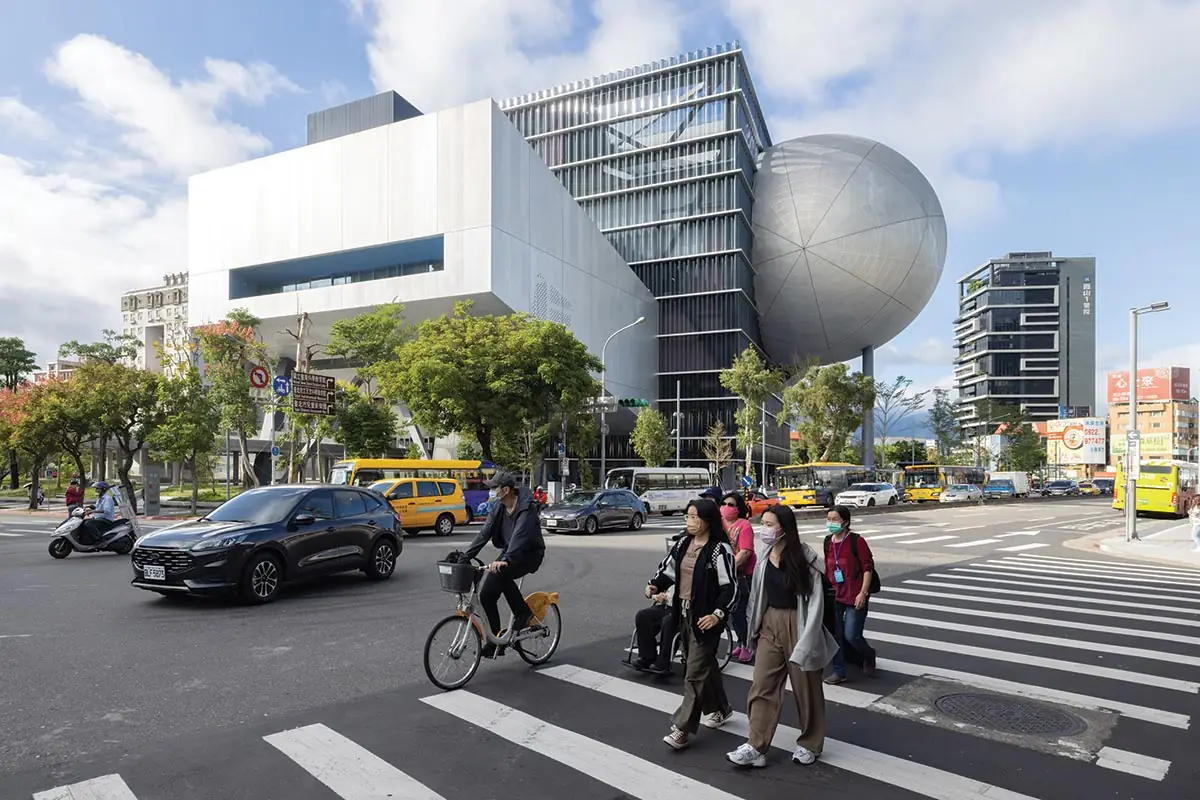
Located at a major intersection (above), TPAC commands attention despite the city’s vibrant lights and signs (top). Photo © Iwan Baan, click to enlarge.
The Taipei Performing Arts Center (TPAC) comes as close as any contemporary building to embodying Shinohara’s vision. Designed by an OMA team led by partners Rem Koolhaas and David Gianotten and project director Chiaju Lin, with the Taiwan-based firm KRIS YAO | ARTECH, the center was first proposed in 2008 for a site in the city’s Shilin district and is now complete, after a tortured construction process marked by the general contractor’s bankruptcy. The building takes the form of a 10-story glass cube from which three aluminum-clad volumes—a rectangular prism, a wedge, and a slightly distorted sphere—protrude awkwardly, supported by long columns that touch down on a sweeping plaza below. In order to unlock the near limitless range of possible configurations and uses dreamed of by performers, the architects have pulled three theaters out of the cube—or, rather, crashed them, stage-first, into the cube, enabling the stages and backstage areas to be joined in various ways. Two of the three—a 1,500-seat proscenium theater with conventional raked seating (the wedge) and an 800-seat flexible “blue box” (the prism)—can become a single, enormous space when partition walls are moved, a feature that proved useful for runway shows during Taipei Fashion Week. The third, an 800-seat “globe” that is naturally housed within the sphere, can expand into a backstage rehearsal room.
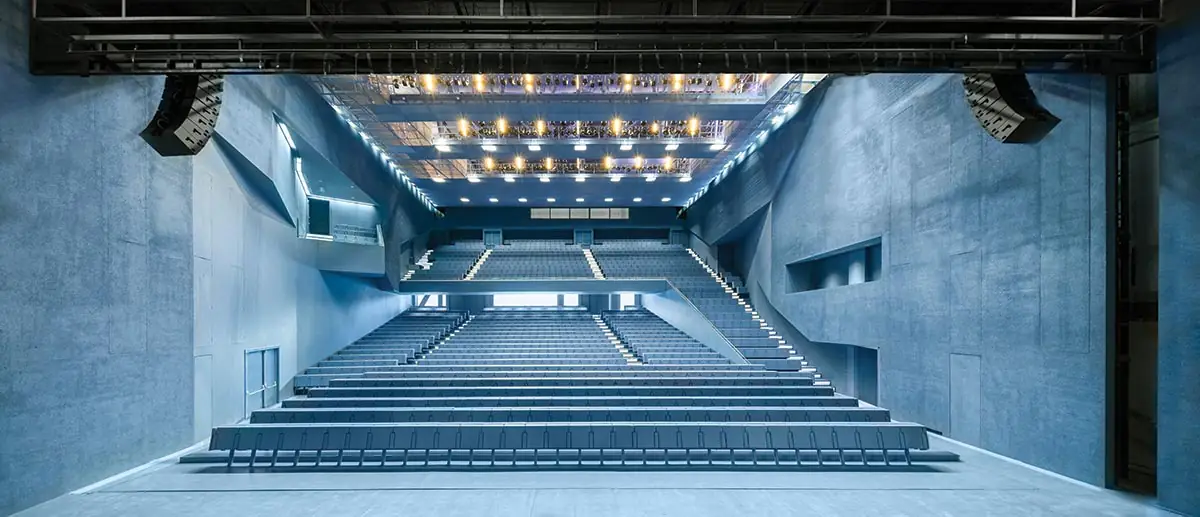
The 1,500-seat grand theater projects from TPAC’s south face. Photo © Shephotoerd Photography, Courtesy OMA
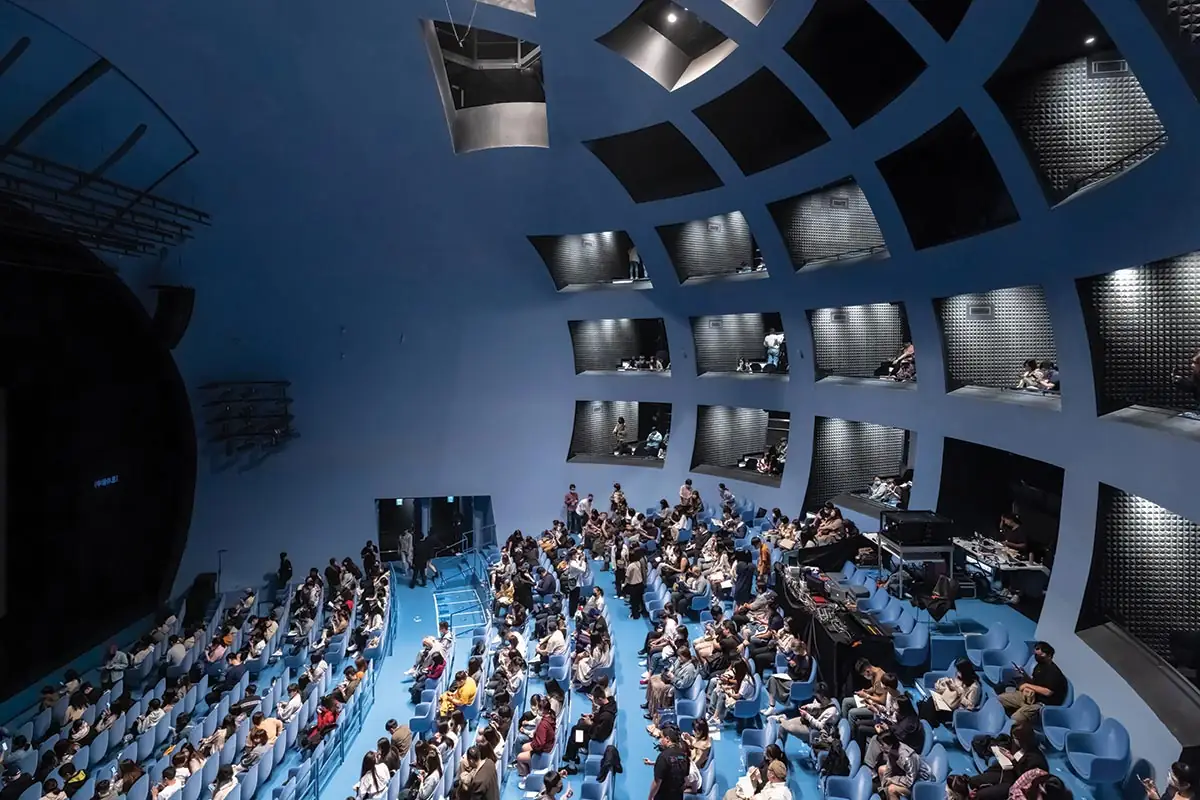
An 800-seat theater is housed within the spherical protrusion. Photo © Iwan Baan
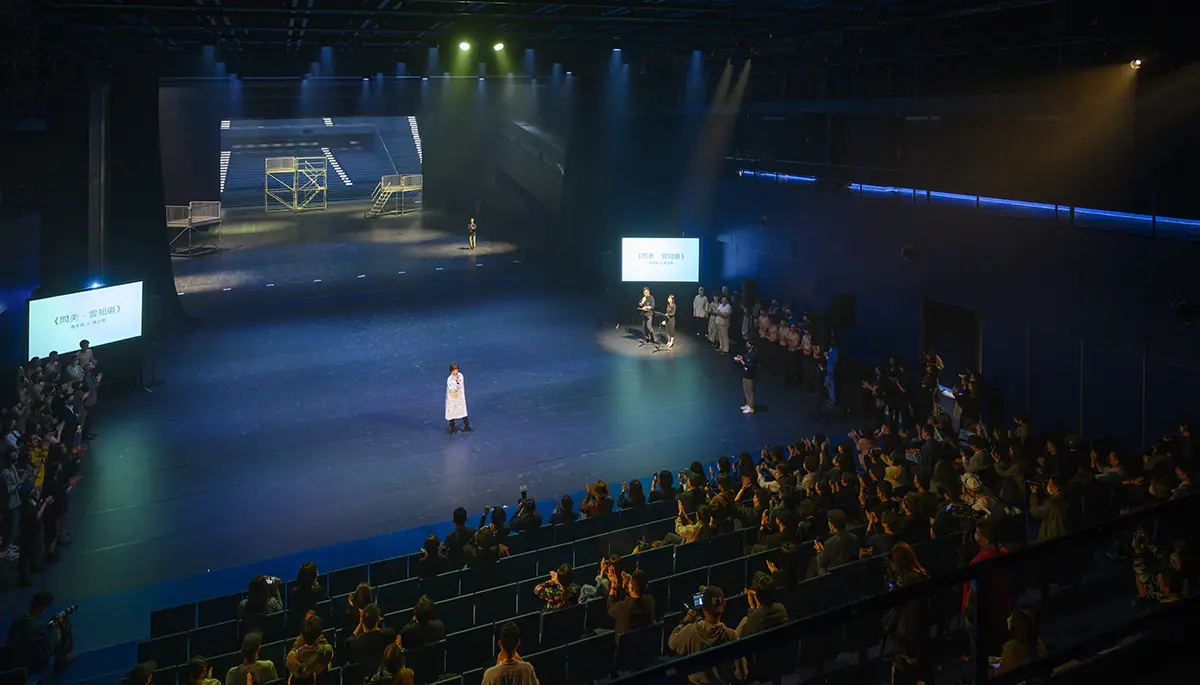
The backstage areas of two of the theaters can be joined together to create a single, enormous space when partition walls are removed. Photo © Shephotoerd, Courtesy of OMA
In its ingenious flexibility, TPAC takes its place within a history of OMA’s investigation of the theater—from one of Koolhaas’s first built projects, the Netherlands Dance Theater in the Hague (1987) to the Wyly Theater in Dallas—and that of the firm’s pursuit of architecture that can be transformed by its users. “I find it difficult as an architect to be specific, because each specificity excludes or kills other possibilities,” says Koolhaas. By enabling the theaters to be combined, “we were able to offer both specificity and an alternative to specificity.”
Beyond the diagram of three floating theaters surrounding a core, another, less obvious one is at work: that of a “public loop” that winds its way from the ground floor to a top-level viewing platform and down again, passing by various front- and back-of-house spaces along the way. Within the loop’s darkened spaces, members of the public gaze through apertures that afford sometimes voyeuristic views of theater in the making. The loop culminates in a curved black room above the globe from which observers can catch a glimpse of rehearsals or performances, and here the building’s second theme emerges: the demystification of theater. This theme is also evident in the building’s unusually welcoming sequence of public spaces, which pulls visitors from the plaza through a three-level lobby that remains open throughout the day, and in theaters that are utilitarian, rendered matter-of-factly in blue, with no trace of pomp or deep-red luxury. Throughout the interiors, the processes of construction and operation are revealed, from the fireproofed steel structure that threads its way around the central cube (enabling the long spans needed within the theaters) to OMA’s familiar unpainted drywall. The loading docks are raised to the second floor, via a concrete ramp, placing oft-hidden logistics on public display. And the cube’s undulating glass facade (see sidebar, below) becomes a distorted lens through which backstage spaces are revealed—and through which outward views of the city become equally theatrical.
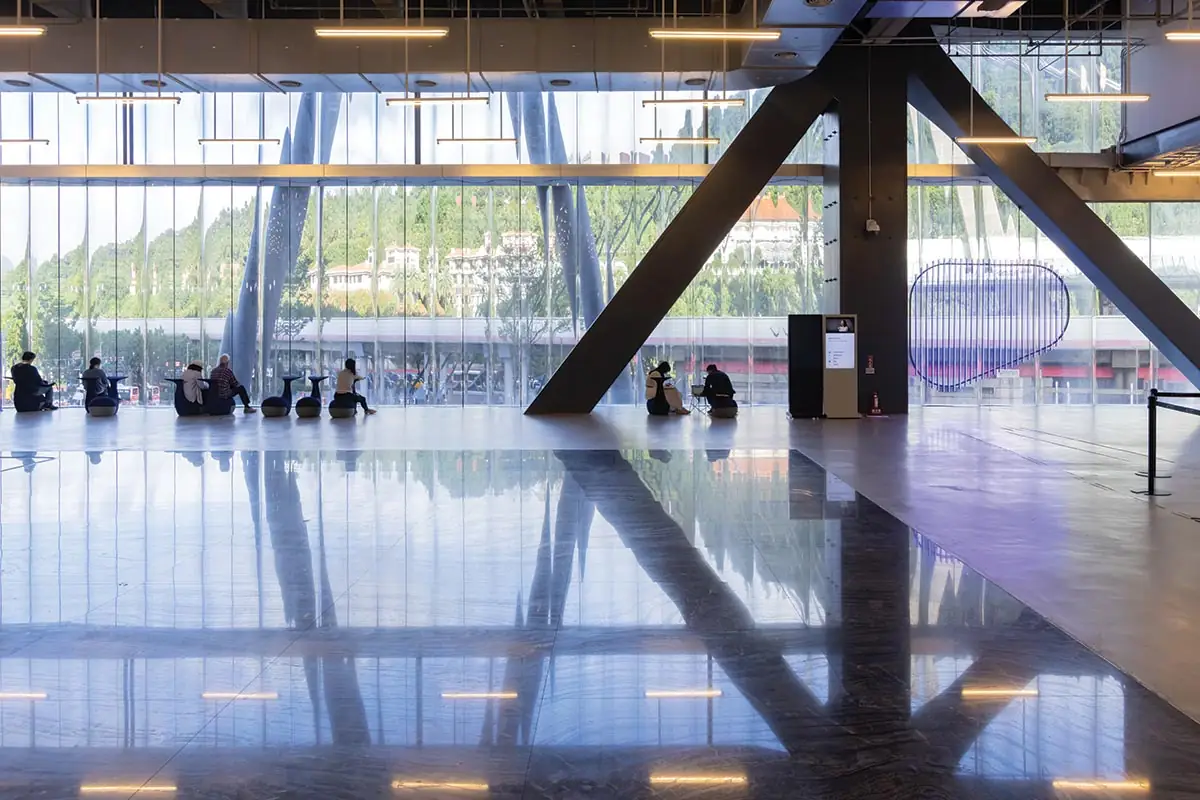
1
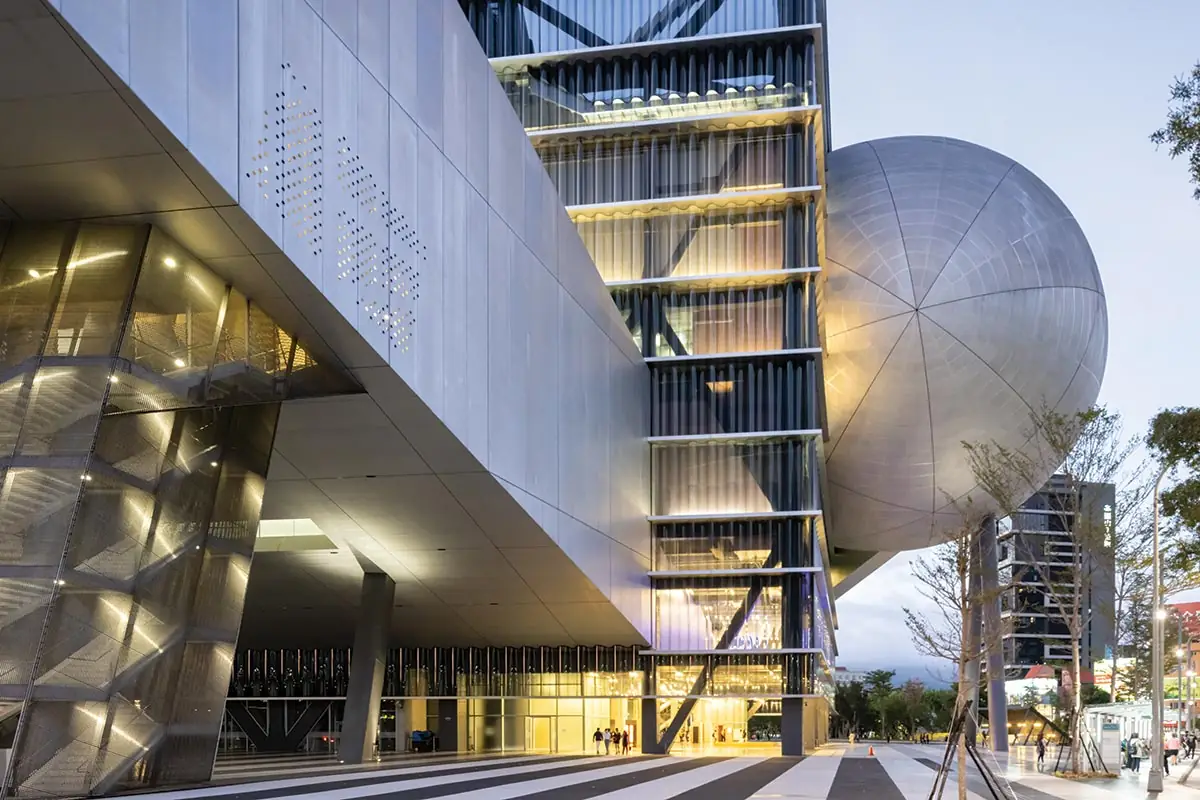
2
A sequence of public spaces, including the multilevel lobby (1), pulls visitors from a plaza (2) into the building. Photos © Iwan Baan
“There have been a few moments where we tried to articulate a theory in a building—where we tried to address the issue of the maximum you can achieve” given practical constraints, says Koolhaas, and most remain unbuilt. “This is part of that sequence, with those ambitions, but built.”
Koolhaas, ever transgressive, initially proposed lifting the three theaters in order to enable the site’s previous occupant, the informal, boisterous stalls of the Shilin Night Market, to continue operating in their shadow. Political concerns nixed this idea—the market was instead moved nearby—but OMA’s concept retained its provocative undermining of hierarchies. As a work of “good sabotage,” in the words of ARTECH founder Kris Yao, TPAC questions theater’s inflated social status and the luxe architecture that typically supports it.
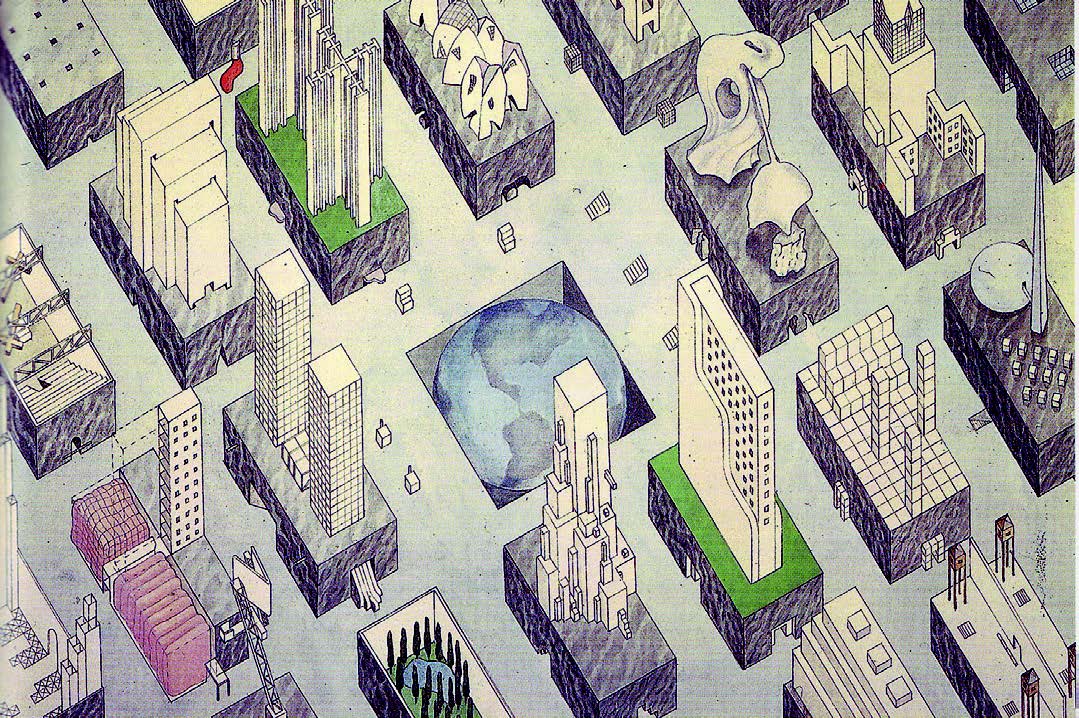
Spheres have been a leitmotif for Koolhaas at least since his 1972 “city of the captive globe” speculative project. Illustration © Rem Koolhaas with Zoe Zenghelis, courtesy OMA
One way the building inverts hierarchies is in speaking the language of the city. In Taipei, everyday life is made visible through architecture: like a “chaotic Tokyo,” as Lin describes it, the city is crammed full of signs, lights, and banners that compete happily for attention. Standing tall over a major intersection, an elevated metro station to one side with mountains just beyond, and a set of narrow lanes branching off across the street, TPAC embraces Taipei. Its disjointed forms seem always to be in motion, as if jostling with the dense crowd of buildings. Each of its faces is distinct, but what most visitors will remember is Koolhaas’s looming aluminum globe, a sphere within the urban labyrinth easily visible from afar. Spheres have been a leitmotif for Koolhaas at least since his speculative 1972 project “city of the captive globe.” And in Delirious New York, his mythic 1978 manifesto, he comments that the appearance of spheres in Western architecture coincides “with revolutionary moments” in history. Taiwan today—a democracy with a potent counterculture that has emerged both in spite of and because of the perpetual threat of a Chinese invasion—seems fittingly revolutionary.
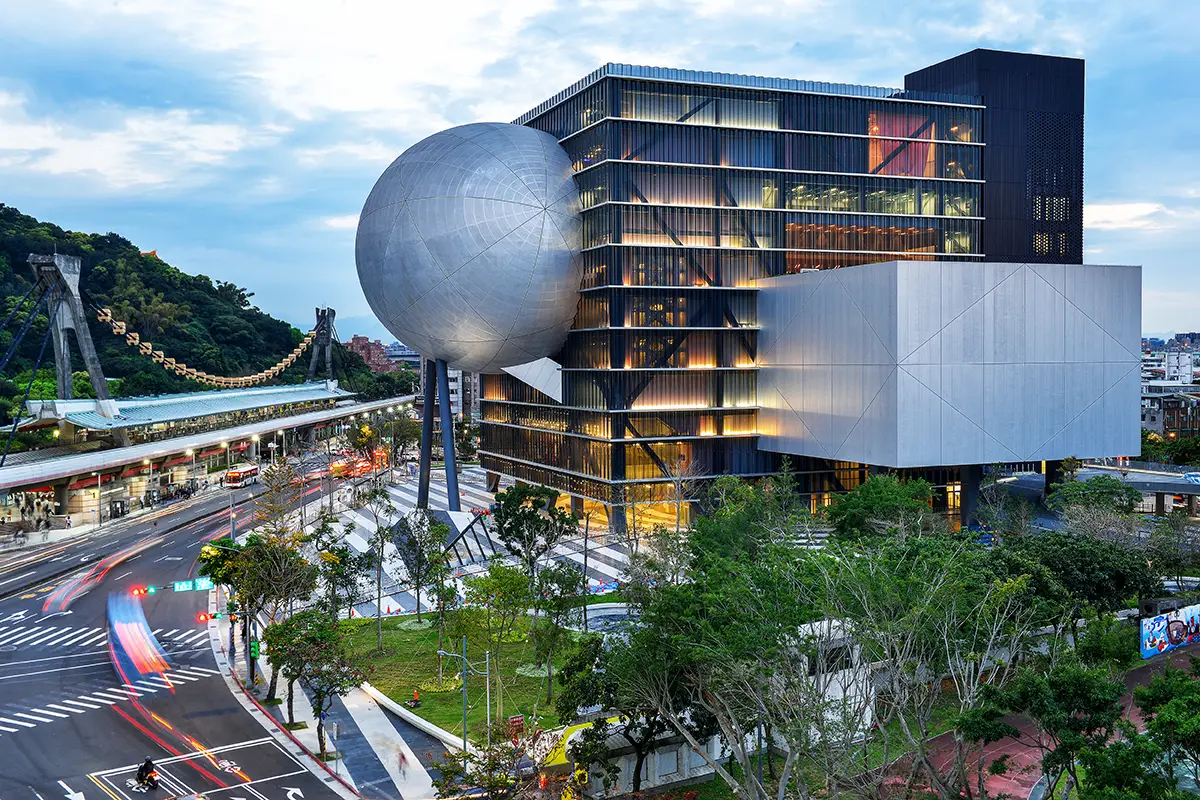
An elevated metro station sits to one side of TPAC, with the mountains just beyond. Photo © OMA, Photography by Chris Stowers
But whereas most of Taipei is filled with explicit symbols, this building is signless and mute, a machine whose parts are made visible but refuse to speak. As a result, TPAC has become a subject of widespread interest in a way that now seems rare for architecture. What, the public asks, could these strange forms mean? Some call it huaji, or comical, on account of a popular theory that each of its volumes represents a different Taiwanese food often sold in night markets. Others compare it to the popular dish of preserved duck egg with tofu. And TPAC has sought to explain the building by likening it to three-broth hot pot. The battle of culinary metaphors has become a way of collectively making sense of architecture—“a way of digesting it,” in Koolhaas’s apt phrase—and the building has itself become a kind of public performance; its abstract forms, like the costumed dancers of Oskar Schlemmer’s Triadic Ballet, tempt observers to interpret it through their own cultural lenses.
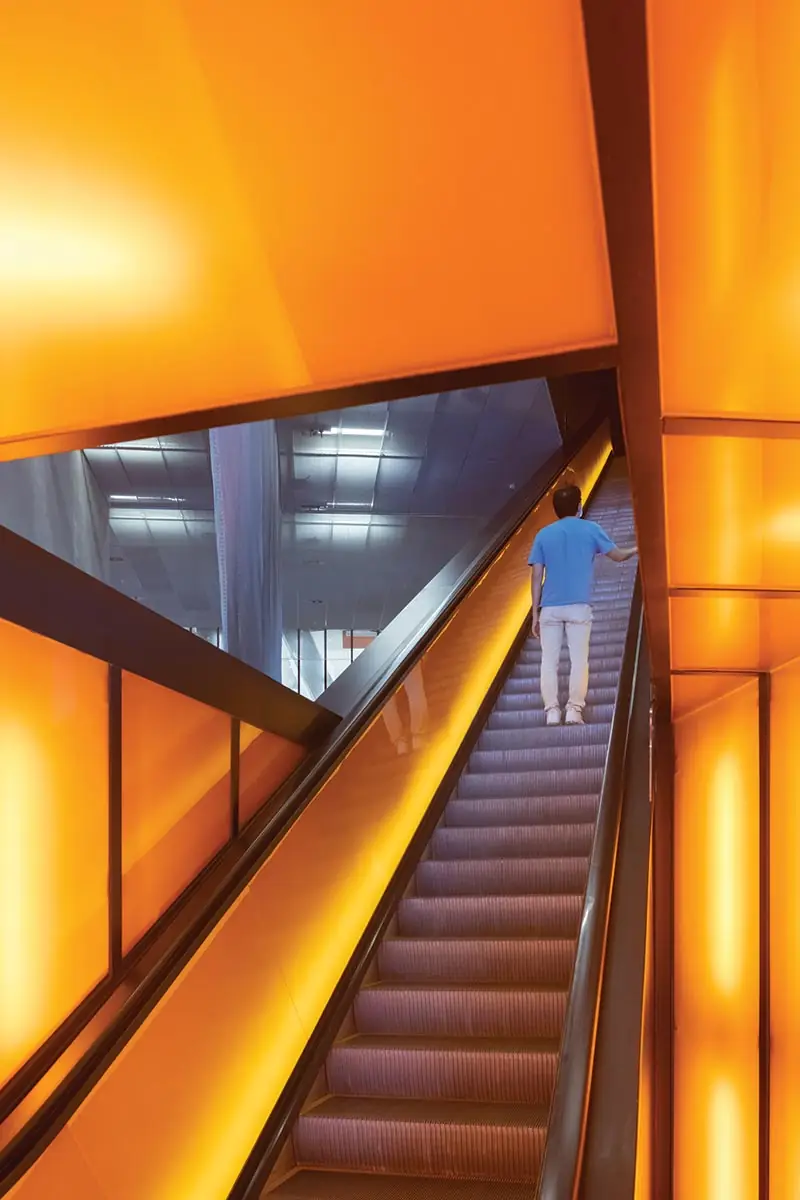
Escalators carry visitors to upper levels where they get a glimpse of backstage spaces. Photo © Iwan Baan
At TPAC, then, the show begins long before the theater doors are open. It begins even before trucks arrive at the stagelike loading docks or the public loop fills with visitors. Here, everything, from seeing the city through distorted glass to interpreting the architecture, becomes a matter of performance and observation. Once the elitist box circumscribing the art of theater is torn away, theater is freed to enter into every aspect of life.
One might ask whether, in diffusing the idea of theater, the building upstages the very performances it was built to house. But, come evening, as the sun sets and signs light up across Shilin, crowds of eager theatergoers can be seen moving slowly toward TPAC as if pulled in by the sphere’s gravitational force. And as you walk across the plaza—passing teenagers snacking and taking selfies—and as you ride the escalator up to have your ticket checked and then again, up farther, to the doors of the immersive blue theater, and at last settle into your seat, the old excitement of going out for a show returns in full force. Then the lights go down, the curtain rises, and this revolutionary building disappears, as it should.
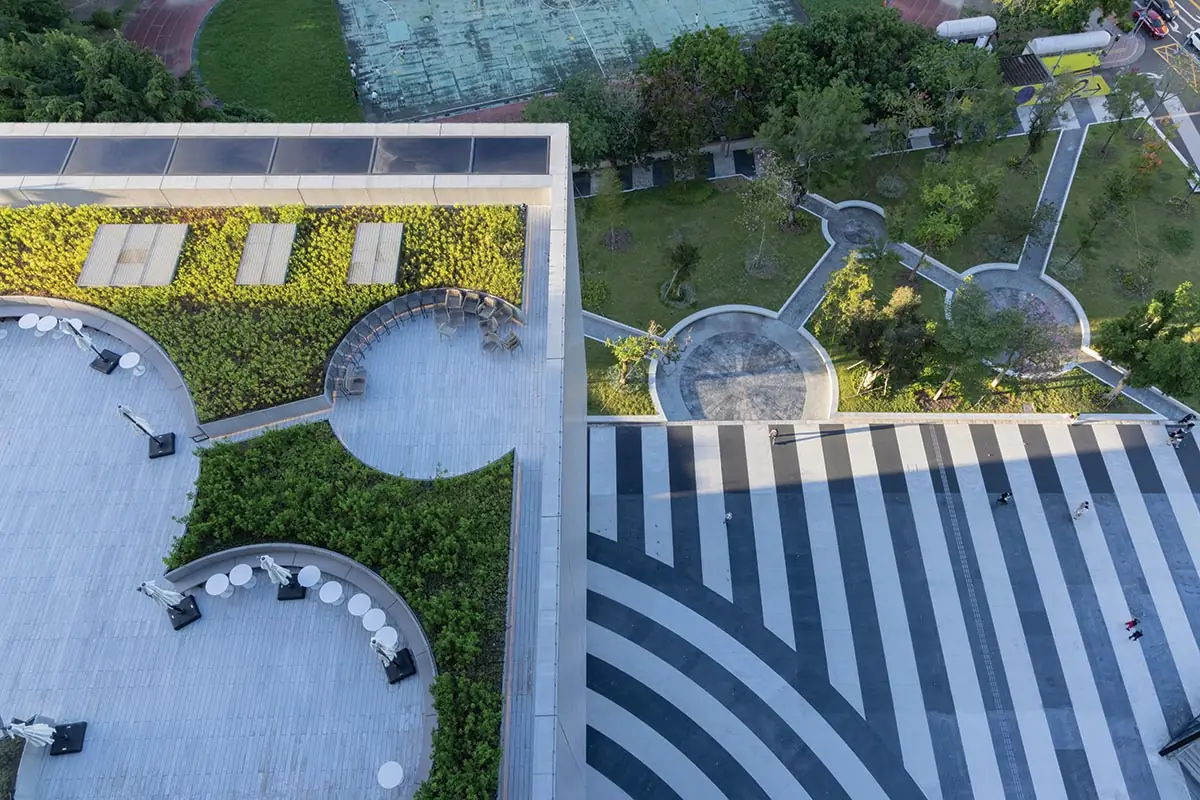
3
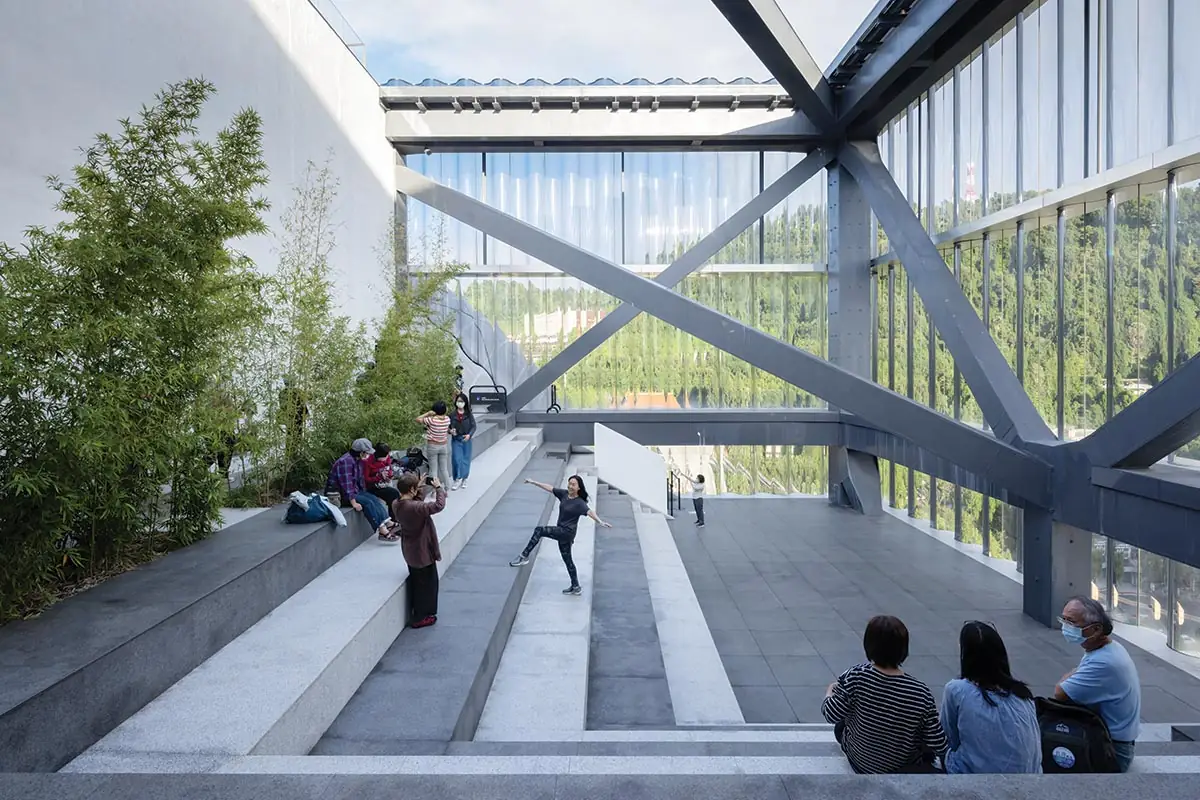
4
A terrace (3) is connected to a seventhfloor restaurant, while a top-floor outdoor viewing platform (4) is part of the public circulation route that winds its way through TPAC. Photos © Iwan Baan
A See-Through Machine

Photo © Iwan Baan
At the Taipei Performing Arts Center, several familiar elements of past OMA projects make appearances, none more noticeable, perhaps, than the corrugated glass that clads three sides of the central cube, recalling the Casa da Música in Porto (2005) and Qatar National Library. In each, the distorted views and reflections created by the glass become a critical design element—but corrugated glass also brings important practical benefits. Its structural stiffness means that large, thin panels can be used—in Taipei, most measure more than 15 feet in height and vary in depth between a half-inch and an inch depending on wind load—without the need for mullions or vertical structure of any kind. And its undulating form diffracts sound rather than reflecting it in a single direction, reducing echoes in spaces used for rehearsals and small performances.
The glass used in Taipei, an annealed laminate manufactured by Barcelona-based Cricursa, is an improvement over that of past projects in the planimetric profile of each panel: whereas the panels were formerly omega-shaped—that is, the joints were at the crests of the undulating waves—here most are S-shaped, so the joints are located between the waves and are less visible when the facade is seen straight-on. (Certain panels are half as wide, and those at the building’s corners are three-quarter circles.) Each panel is vertically supported at three points by steel shelves that are in turn tied to the floor slabs, according to Ronald Wenting, a facade engineer with the firm ABT, who worked both on TPAC and the Qatar National Library. “The forces need to run in a clear way through the structure” in order to prevent the glass from cracking, he says—especially given that Taiwan regularly experiences both earthquakes and typhoons. (The structure is base-isolated to address Taipei’s high seismicity.)
The design and execution of the facade was in a sense “the biggest technical challenge of the project,” says Kris Yao, the founder of KRIS YAO | ARTECH, which partnered with OMA as local architect of record. Particularly difficult was producing the custom panels that interface with the aluminum sphere of the globe theater. Because already-curved panels could not be cut on-site, contractors cut plywood “dummy panels” that reflect the sphere’s not-always-exact curvature and that were then used to make molds for the glazing. In total, the building has over 1,200 corrugated glass panels, of which more than 50 are customized. Each panel has a two-element PVB (polyvinyl butyral) interlayer that reduces solar heat gain and gives the building a dark tint when seen in bright sunlight.
Further challenges arose in dealing with the tolerances where different materials meet, and, in a few spots (including the interface with the sphere), the contractors’ execution of visible details leaves something to be desired. But, in a building as industrial as this one, such evidence of difficulty will not be noticed by most visitors. Much more important, the corrugated glass enables the cube at night to become an “almost see-through machine that suggests what’s happening inside,” says Chiaju Lin of OMA—a sharp contrast to the opaque theaters that, she says, “float mysteriously in the air.” IK
Click plans to enlarge
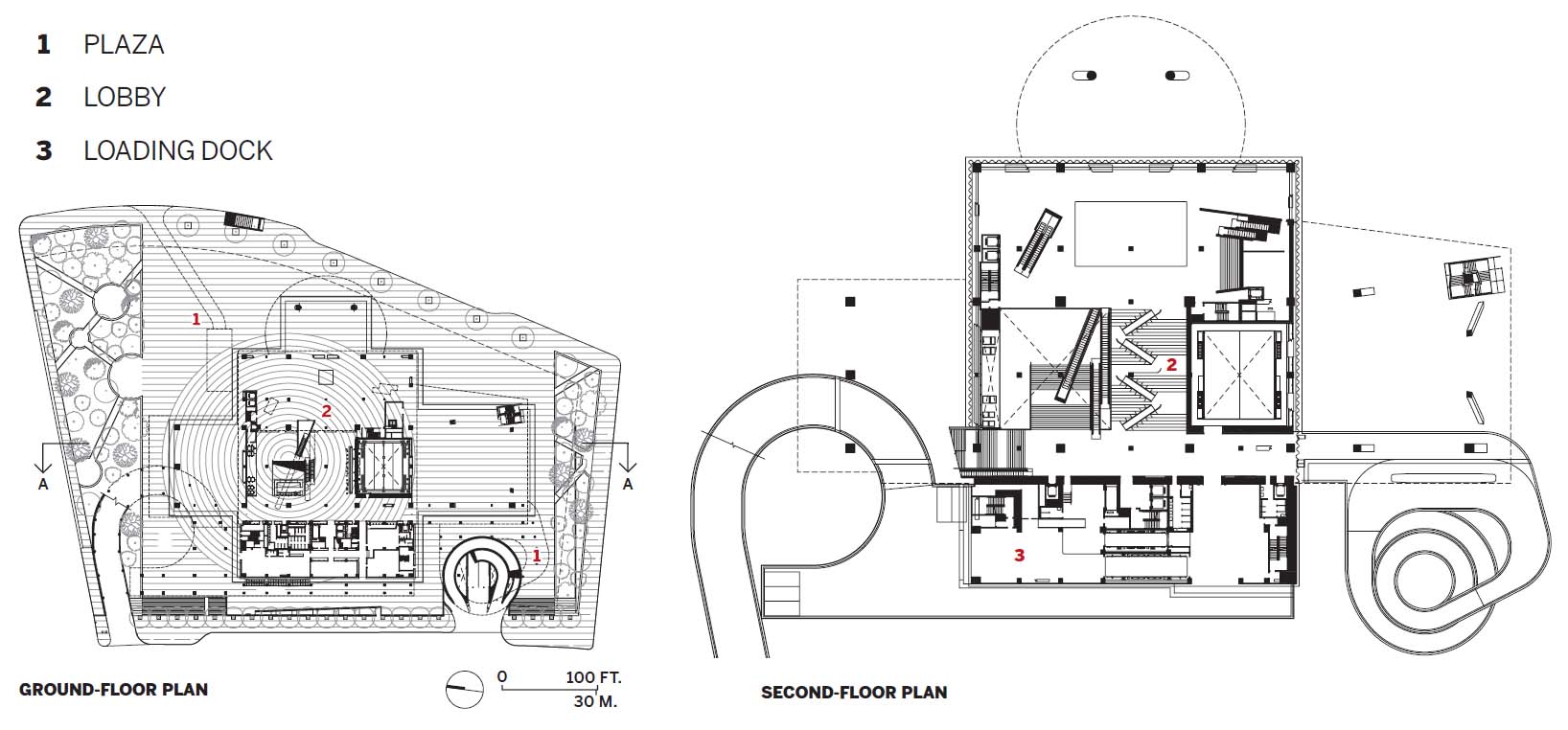
Click plan to enlarge
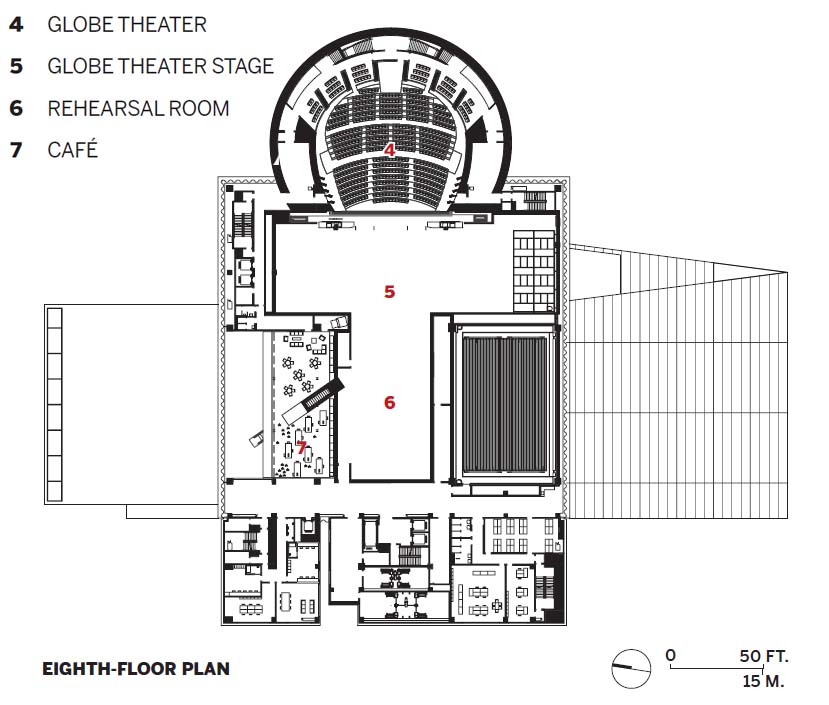
Click section to enlarge
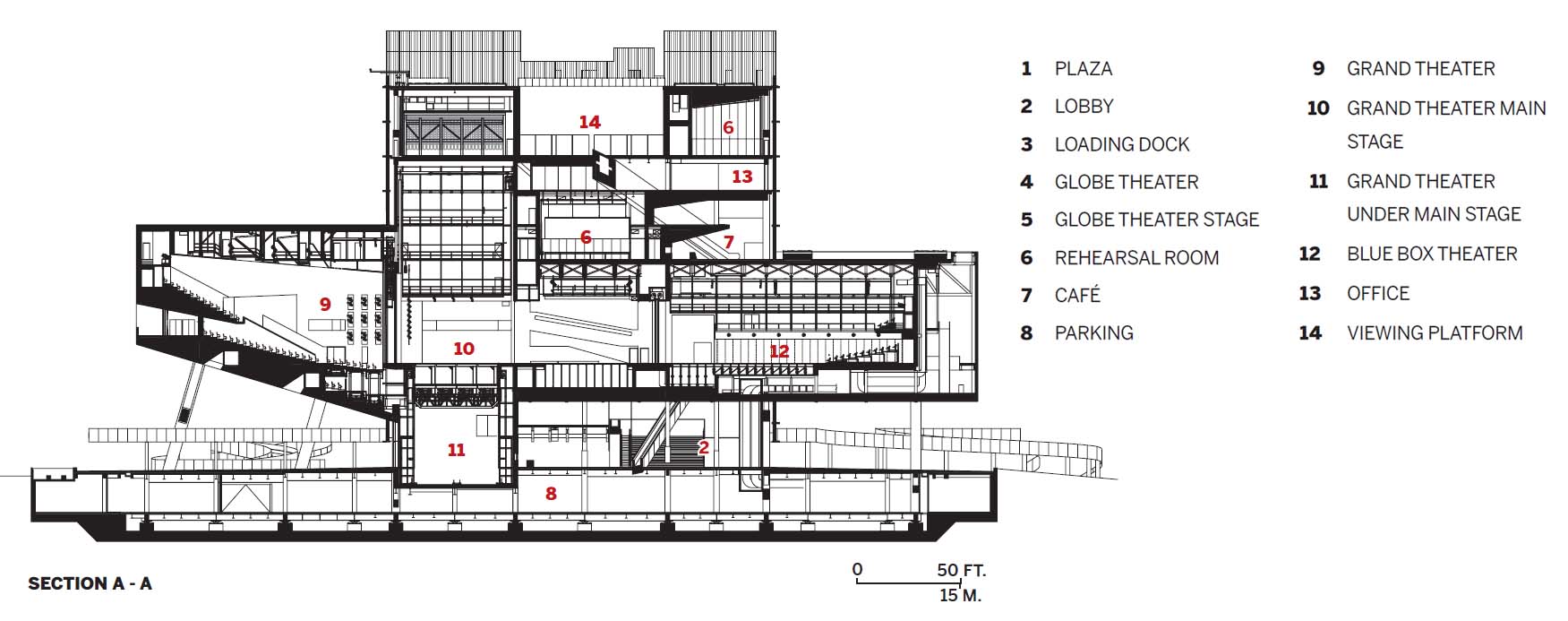
Click drawing to enlarge

Credits
Architect:
OMA — Rem Koolhaas, David Gianotten, partners in charge
Construction Phase (2012 – 2021):
Project Director:
Chiaju Lin
Associates:
Paolo Caracini, Inge Goudsmit, Daan Ooievaar
Team:
Vincent Kersten, Han Kuo, Kevin Mak, Chang-An Liao, with Yannis Chan, Hin-Yeung Cheung, Meng-Fu Kuo, Nien Lee, Nicole Tsai
Design Development Phase (2009 – 2013):
Project Architects:
Ibrahim Elhayawam, Adam Frampton
Team:
Yannis Chan, Hin-Yeung Cheung, Jim Dodson, Inge Goudsmit, Alasdair Graham, Vincent Kersten, Chiaju Lin, Vivien Liu, Kai Sun Luk, Kevin Mak, Slobodan Radoman, Roberto Requejo, Saul Smeding, Elaine Tsui, Viviano Villarreal-Buerón, Casey Wang, Leonie Wenz
Competition Phase (2008 - 2009):
Partners-in-Charge:
Rem Koolhaas and David Gianotten, in collaboration with Ole Scheeren Project Architects: Adam Frampton, Mariano Sagasta Garcia, André Schmidt
Team:
Erik Amir, Joshua Beck, David Brown, Jean-Baptiste Bruderer, Andrew Bryant, Sean Hoo Ch'ng, Steven Yingnien Chen, Dan Cheong, Ryan Choe, Antoine Decourt, Mitesh Dixit, Pingchuan Fu, Miguel Huelga de la Fuente, Alexander Giarlis, Richard Hollington, Takuya Hosokai, Shabnam Hosseini, Nicola Knop, Ippolito Pestellini Laparelli, Chiaju Lin, Sandra Mayritsch, Vincent McIlduff, Alexander Menke, Gabriele Pitacco, Shiyun Qian, Joseph Tang, Agustín Pérez Torres, Xinyuan Wang, Ali Yildirim, Patrizia Zobernig
Executive Architect:
Kris Yao | Artech
Engineers:
Arup (structure, m/e/p, building physics, fire); Evergreen Consulting Engineering (structure); Heng Kai, IS Leng and Associates Engineers (building services); Taiwan Fire Safety Consulting (fire)
Consultants:
dUCKS Scéno, Creative Solution Integration (theater); Royal HaskoningDHV, Theo Raijmakers, SM&W (acoustics); Chroma 33 (lighting); ABT, CDC (facades); Segreene Design and Consulting (sustainability); Inside Outside (landscape design, interior design); CNHW (landscape)
Contractors:
International Engineering & Construction (former general contractor); Sun-Sea Construction (facades); Ancang Construction (interior and landscape); Jung Yan Interior Design & Decoration, Tech-Top Engineering (m/e/p, fire); Shiu Guan Machine Electric Engineering (AC); Jardine Schindler Lifts (elevators)
Client:
Taipei City
Size:
630,000 square feet
Cost:
$188 million
Completion Date:
July 2022



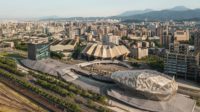
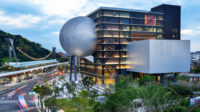
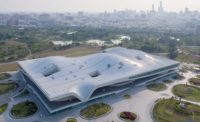
Post a comment to this article
Report Abusive Comment